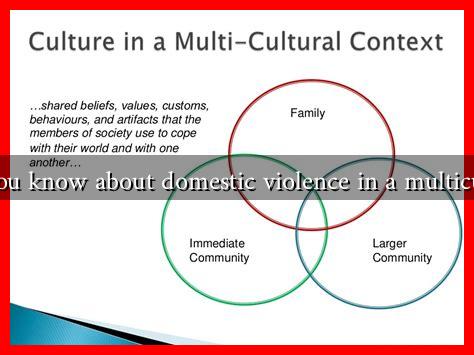-
Table of Contents
What Should You Know About Domestic Violence in a Multicultural Context?
Domestic violence is a pervasive issue that transcends cultural, ethnic, and socioeconomic boundaries. However, understanding domestic violence within a multicultural context requires a nuanced approach that considers the diverse backgrounds and experiences of individuals. This article explores the complexities of domestic violence in multicultural settings, highlighting the unique challenges faced by various communities and the importance of culturally sensitive interventions.
The Definition of Domestic Violence
Domestic violence, often referred to as intimate partner violence, encompasses a range of abusive behaviors that occur within intimate relationships. These behaviors can be physical, emotional, psychological, or financial. According to the World Health Organization (WHO), approximately 1 in 3 women worldwide have experienced physical or sexual violence in their lifetime, often at the hands of an intimate partner.
Cultural Influences on Domestic Violence
Cultural norms and values significantly influence perceptions of domestic violence and the responses to it. In many cultures, traditional gender roles may perpetuate the idea that men are dominant and women are submissive, which can normalize abusive behaviors. Some key cultural factors include:
- Gender Roles: In patriarchal societies, men may feel entitled to control their partners, leading to higher rates of domestic violence.
- Stigma and Shame: Victims may fear social ostracism or shame, making them less likely to seek help.
- Language Barriers: Limited English proficiency can hinder access to resources and support services.
- Immigration Status: Undocumented individuals may fear deportation if they report abuse, creating a barrier to seeking help.
Statistics and Case Studies
Understanding the prevalence of domestic violence in multicultural contexts is crucial for developing effective interventions. Here are some statistics that illustrate the issue:
- According to the National Coalition Against Domestic Violence (NCADV), women of color experience higher rates of domestic violence compared to white women.
- A study by the Asian Pacific Institute on Gender-Based Violence found that 41% of Asian women reported experiencing intimate partner violence in their lifetime.
- In the LGBTQ+ community, rates of domestic violence are alarmingly high, with 1 in 3 LGBTQ+ individuals experiencing intimate partner violence.
Case studies also provide insight into the unique challenges faced by different communities. For instance, a study conducted in a South Asian community revealed that cultural expectations around marriage and family honor often prevent victims from seeking help. Many women reported feeling trapped by the fear of bringing shame to their families.
Culturally Sensitive Interventions
Addressing domestic violence in a multicultural context requires culturally sensitive interventions that respect and understand the unique backgrounds of victims. Some effective strategies include:
- Community Engagement: Involving community leaders and organizations can help build trust and encourage victims to seek help.
- Language Services: Providing resources in multiple languages ensures that non-English speakers can access support.
- Tailored Support Services: Developing programs that consider cultural beliefs and practices can make services more accessible and effective.
- Education and Awareness: Raising awareness about domestic violence within specific cultural communities can help challenge harmful norms and promote healthier relationships.
Conclusion
Domestic violence is a complex issue that requires a multifaceted approach, particularly in multicultural contexts. Understanding the cultural influences that shape perceptions of domestic violence is essential for developing effective interventions. By recognizing the unique challenges faced by diverse communities and implementing culturally sensitive strategies, we can work towards reducing domestic violence and supporting victims in their journey towards healing.
For more information on domestic violence resources and support, visit the National Coalition Against Domestic Violence.

